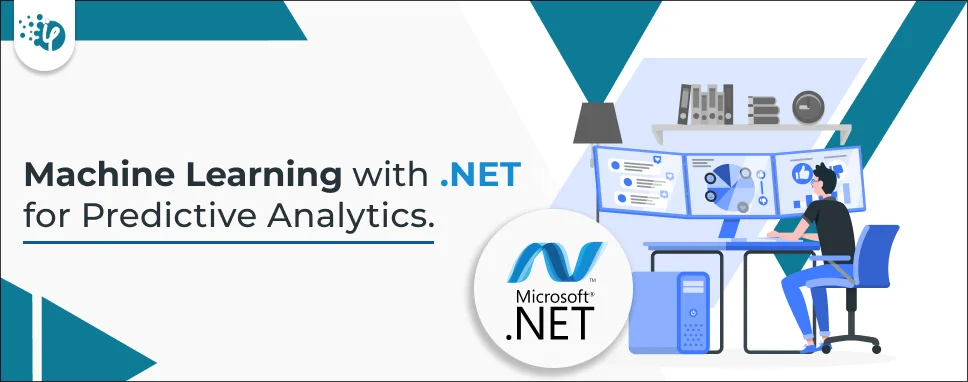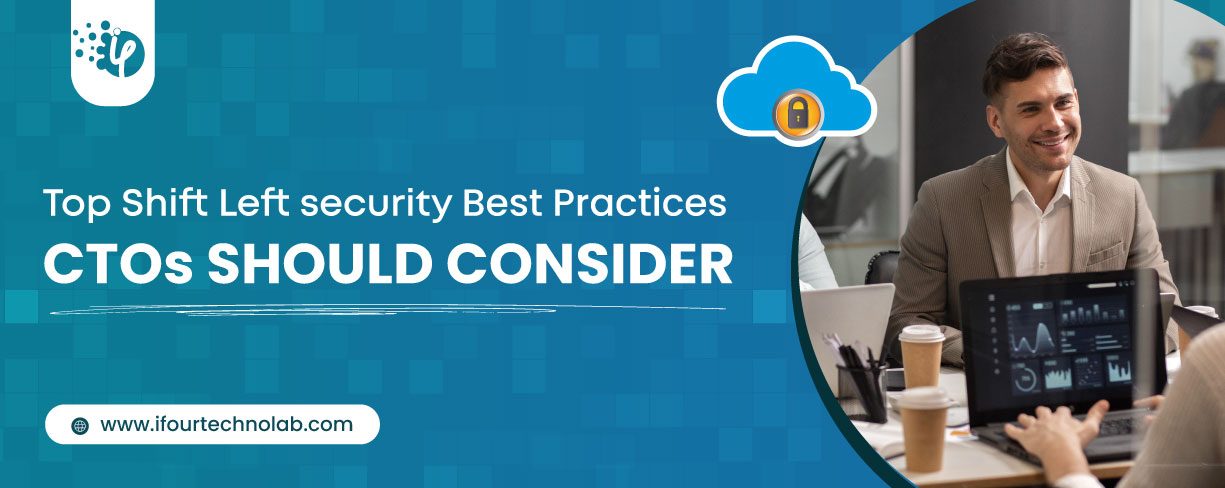Modernizing applications with the 7 R strategy – A CTO’s Guide
Think about the last time CTOs spent most of their time fixing old systems. Updates were slow, servers were expensive, and adding new features took time. Now, things have changed....
Listening is fun too.
Straighten your back and cherish with coffee - PLAY !

Many companies rely on advanced technologies to make informed decisions in their business. For instance, some Chief Technology Officers (CTOs) turn to Power BI consulting services, while others prefer using Tableau for data analysis. However, there is another powerful tool that simplifies predictive analytics for business consultants, and that is ML.NET (Machine Learning with .NET technology).
This advancement in predictive analytics allows CTOs to forecast trends and make decisions more strategic. With the fusion of ML and .NET, they would benefit from powerful capabilities helpful in forecasting data. Let’s delve further and learn more about this synergy, its features, and the possibilities it can bring.
The .NET is a widely popular framework among programmers all around the world. The framework is highly versatile and secure. It supports multiple programming languages and has a rich ecosystem of libraries. Integration of ML in this .NET framework has become a huge trend in the last few years. It completely changed how we approach application development. Below, we gathered the biggest benefits of approaching Machine learning with ML.net.
ML algorithms can handle large volumes of data and complex computations. They improve the processing capabilities of .NET applications. These models can boost efficiency and reduce latency. Also, they can allocate resources based on workload demands and system constraints. It allows you to maintain consistency in performance.
Plus, this integration lets you deploy scalable infrastructure architectures. You can adjust them to the growing demand of applications. That way you can get optimal results at lower costs.
The .NET machine learning algorithms give you the possibility to uncover specific patterns and trends. ML-driven applications process different sources, like
They outline valuable insights that can help you make decisions. Moreover, they can comprehend individual preferences and context. So, they can suggest the most relevant products and context to the users.
Also, they offer automation capabilities. So, you can maximize your productivity through this integration. They can even automate compliance monitoring and reporting processes. That way you can identify any potential violations and adhere to all the standards.
This integration can speed up all the development processes. You can use pre-built ML models and libraries. They have tons of available algorithms and techniques. They cover different use cases, like
Also, these systems have built-in support for testing frameworks. You can easily check how your applications work in different environments and scenarios. Plus, most of these systems are open-source. So, you can use your collective expertise to handle different tasks faster. In case of proper guidance, you can even hire .NET Core developers and produce great outcomes.
The important facet is to work with a reliable partner who can understand needs. iFour Technolab can be the right platform to hire .NET Core developers , our programmers are highly experienced and hold enough expertise in the field to produce great outcomes.
Another big advantage is compatibility with other infrastructure components, like
It gives you the possibility for smooth integration without disrupting established workflows. Also, these systems can easily use your current data stores and repositories. So, you won't have to transfer or duplicate any information. Plus, .NET is known for its modular design. So, you can incorporate ML functionalities into existing applications.
As we've mentioned before this integration gives many possibilities for predictive analytics. But first, let’s get to know what predictive analysis is. It’s called the procedure of future forecasting by using historical data and analytical algorithms. These models can determine tendencies and suggest optimal courses of action. It allows you to anticipate market dynamics and optimize your resources.
Predictive analysis using ML and .NET gives you the possibility to easily build solutions. You can develop them according to your needs with the help of available instruments. We gathered the steps you need to take to complete this process.
It is crucial to train the model with the quality and relevance of the data for successful predictive analytics. So, you'll need some thorough preparation. Make sure that your dataset is clean and consistent. You can use the ML libraries to perform cleaning tasks, like
The next step is feature engineering. You need to select and transform appropriate attributes from the raw data to create predictors for the model. Some of the techniques you can use for that are
Remember that you'll have to validate all the features throughout this process. You need to assess their effectiveness for your model. Building predictive analytics solutions with ML and .NET is easier when you have the right datasets on hand.
Before you start the actual training process, you need to pick the right algorithm. Some of the options are
Next, you need to input the prepared data into algorithms. They'll learn patterns and relationships necessary for predictions. You can train the models with the help of Machine Learning .NET intuitive APIs. They support both supervised and unsupervised learning paradigms. You can adjust any parameters during the training process. Some of the techniques we recommend using are cross-validation and hyperparameter tuning.
Also, you need to constantly evaluate how your model performs. Pay attention to metrics like
They can help you determine if the model can make correct predictions and identify true positives and negatives.
Last but not least you need to continuously refine and adapt your model. It's important to regularly assess the input data. You can implement governance practices to maintain its integrity and consistency. Make sure to add any new information.
Also, we recommend incorporating feedback loops. Try to collaborate with data scientists, domain experts, and end-users. They can give you some useful suggestions on how to improve your model.
Moreover, you can use automated re-training pipelines. They'll regularly update your models with fresh data and evolving trends. You can implement techniques like
Also, try to foster a culture of constant learning within your organization. Encourage cross-functional cooperation to drive innovation. Follow best practices for using ML.NET in predictive modeling.
There's no doubt that this synergy can be beneficial in many ways. We already discussed how it can change our approach to predictive analysis. Now, you probably want to know about some practical solutions you can use. So, we gathered some of the best .NET machine learning libraries available.
This one was developed by Microsoft. They created it specifically for the .NET ecosystem. You can use it to build and deploy custom models with the help of C# or F#. It has a huge set of APIs. So, this library can support different ML tasks, including
Also, it integrates with Visual Studio and Azure services. So, the further processes of development and training become much simpler. In short, predictive modeling with C# and ML.NET. can be simplified by choosing the right framework.
This framework offers many algorithms and instruments for
You can employ advanced techniques like support vector machines and neural networks with it. Also, it has an intuitive API and extensive documentation. So, you can easily use it for rapid prototyping and experimentation.
This alternative allows you to use deep learning capabilities within your .NET applications. You can integrate the TensorFlow models with your codebases. It gives you the possibility to perform tasks like
The combination of Machine learning in .NET applications has a lot of potential. However, there are some considerations regarding it. You need to understand any issues you might have and handle them immediately. Below, we gathered some of the main ethical concerns.
Models trained on biased data can perpetuate and intensify existing societal biases. This may lead to unfair outcomes and discrimination. So, you need to mitigate bias during the development process. You'll have to carefully curate training data and conduct bias audits. This transparency can help you ensure fair treatment and representation across diverse user populations.
As we've noted above, these applications often rely on big amounts of sensitive data. This may raise some concerns about privacy and protection. To handle them you should
Additionally, we recommend providing the usage policies and consent mechanisms. It will show your users that you're open about your practices and trustworthy. Moreover, you can opt to use the .NET predictive analytics tools available.
The opacity of these models can also become a challenge. You should prioritize explainability. For instance, you can
Clear documentation and audit trails can help you promote trust. It allows users to fully understand the outcomes of all the operations.
Another difficulty you might have is failing to meet ethical standards. It's extremely important to deploy this advancement responsibly. You should
That way you can uphold any standards and avoid risks.
We also want to mention that these applications have the potential to influence societal norms and shape public discourse. You must consider the broader societal implications of your work. Try to take into account any
Always interact with stakeholders and consider different perspectives to handle any societal concerns.
By integrating machine learning for hospitality, businesses can tailor their services more precisely, which raises ethical dilemmas regarding privacy and data security. The use of machine learning for hospitality can help address social inequalities by providing personalized experiences to underserved demographics, yet it must be managed to avoid reinforcing existing biases.
The world of application development is constantly changing. One of the latest trends is the ML and .NET combination. It gives you the opportunity to make your operations faster and more accurate. Plus, there are more opportunities for predictive analytics with ML and .NET. There are many accessible libraries and tools you can use for this purpose. We described some of the best alternatives above. Yet, you need to remember to use these advancements responsibly and adhere to all ethical norms.
Hope that you found our guide helpful. Don't be scared to try out innovative combinations. The outcome will definitely be great!
Predictive analytics is having a greater impact on sectors like energy, healthcare, and finance. With predictive analytics, companies can gain deep and real-time insights into their business activity helping to make better decisions.
The list of most popular predictive models includes regression, neural networks, clustering, and decision trees.
There are multiple advantages of using ML.NET for predictive analytics such as it helps to train and select an ideal model for your dataset automatically, it can perform deep learning tasks, and it allows you to make multiple predictions using an ML Model.
Some of the popular .NET libraries for predictive analytics include TensorFlow, Accord.NET, XGBoost, Scikit-learn, etc.
One should follow the below steps for integrating machine learning models into.NET applications;
i. Start with defining use cases,
ii. Collect datasets,
iii. Choose an ML library,
iv. Train the model,
v. Evaluate and implement the model,
vi. At last, update and monitor the model.

Think about the last time CTOs spent most of their time fixing old systems. Updates were slow, servers were expensive, and adding new features took time. Now, things have changed....

According to HackerOne, fixing a security issue after software is released can cost 30 times more than fixing it during development. Today, CTOs take a different approach. Shift...

A few years ago, companies built software first and thought about security later. Developers and security teams did not cooperate, and problems were fixed only after release. This activated DevSecOps vulnerabilities and many DevSecOps failures.